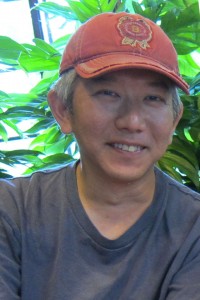Professor Mafuyu Kitahara finished his B.A. and M.A. at Kyoto University and afterward completed his Ph.D. at Indiana University. His fields are Phonetics, Phonology, and Cognitive Science. He came to Sophia University in 2016 and was appointed the director of the Phonetics Laboratory in September. Recently he sat down with the editors of the student journal Angles, to discuss his career, his work, and his teaching.
Angles Editors: Can you tell us how you got started in your field and what affected you the most in the field of linguistics?
Professor Kitahara: I was born in Chiba, raised in Nagano, which is the eastern part of Japan. My father is from Tokyo and my mother is from Yamanashi. Somehow, I decided to enter Kyoto University, and that’s very different! The language and especially the sound, the intonation, the accent of the western dialect is fascinating. That was the very starting point of my interest to the sound of languages. The requirements of linguistic courses at Kyoto University is that you have to take six foreign languages. I had to take many language courses to learn about the general aspects of languages. Not  just about the sound but grammar, words, morphology, and those things.
just about the sound but grammar, words, morphology, and those things.
Angles Editors: After you took those courses you decided to major in Japanese Linguistics or Phonology?
Professor Kitahara: Maybe I should start with the differences between Phonetics and Phonology. Phonetics is more about the sound itself. The making of the sound. How do I move my tongue and jaw? How do I listen to the sound? How does the sound vibrate in my eardrum? How is the sound understood by the brain? Phonology is more about the inner thoughts of the sound. Because we perceive some foreign sounds as being very exotic and then sometimes we imitate in the wrong way. The inner structure of our understanding of the sound and making the sound is the topic of Phonology. I was interested in Japanese phonology and the acceptance of foreign sounds in Japanese and how we deal with those foreign sounds. Of course, it’s hard because there are not many vowels in Japanese compared to English, or the consonants and clusters, the combination of consonants are also hard for Japanese. Those are the things I was thinking about for my research in Japanese.
Angles Editors: How did you start the study of English linguistics after your studies in Japanese linguistics?
Professor Kitahara: Halfway through my Ph.D. program, I decided to enter Indiana University, and stayed there for five years. I got so many inputs, many different forms of English input. It is different from the standard textbook English, and that’s more southern-colored English. Bloomington is the city where the university is, in the southern part of Indiana. Which is close to Kentucky, Missouri, those southern states. Those southern states have southern accents of American English. That was different from my first experience of Kan-sai dialect. Mostly I couldn’t really understand southern-American English. The students in grad school are from all over the world, they are not necessarily southern-accented English speakers, but when I went to local stores like a barber shop, when a person cuts my hair and talks to me in a heavy southern accent. I could understand only 20% of it. Those dialectal differences which I couldn’t experience in Japan, was the first point I was interested in, more into English sounds, not just in Japanese, and the subtle differences among many different Englishes.
Angles Editors: So you learned some dialectal differences in English in America?
Professor Kitahara: We all know that British and American English are different, but I didn’t know, before I went to the United States, that there are so many Englishes in the United States.
Angles Editors: What was one of the biggest challenge that you faced in your career or your studies?
Professor Kitahara: Probably, the second year at graduate school in Indiana. The first year, of course, was very shocking and everything was different, but then I was sort of expecting a big shock. Whatever it is, it’s coming, a big shock, but in the second year, everything is more routine-like but it’s much busier. That year I also started as a TA (teaching assistant) for Japanese courses. There were not so many native Japanese speakers, so I was helping professors giving drill sections for students taking Japanese. It’s hard because they were quite demanding. Professors are kind of away from them, but grad students are so close, so they ask casual questions, for example, “Can you make the test easier?” or “Why I am getting this grade?” Those kinds of questions. Maybe you can understand the feeling.
Angles Editors: What was one of the biggest accomplishment you have had in your career?
Professor Kitahara: The topic of my doctoral thesis was about the devoicing of Japanese. Vowel sounds always have voice, but in Japanese, we have devoicing, especially in Tokyo dialect, where the vowels get no voice. That is already interesting, but we do have accents in Japanese. Accents are the pitch of the voice. When we lose the voice, because of devoicing, where does the accent go? How can you get the feeling of accentedness without the voice? What I found is that there’s no voice in the accented syllable but people can perceive accents because the pitch of the voice around the devoiced area tells the perceiver of the sound, there it is. Especially a very immediate fall of the pitch, it goes down immediately after the devoiced syllable, that also tells the listener. For the recent findings, I’m more interested in Japanese students learning English who are trying to be more fluent speakers, especially working on pronunciation. One of the challenges is the flap sound. Flapping occurs in your mouth, it occurs in a word like “better,” “butter,” “writer,” but of course Japanese students try to read those words the way it looks to them. Flapping is very tough for Japanese students (pronouncing with a tongue lightly touching) and that contrasts with “R” and “L” which are also very hard for Japanese students. But my finding is students can improve. If they stay one semester or one year in English-speaking countries, students can get a lot better. People are not very aware of this change. It’s subconscious, but these little differences can be improved. And that makes your speech more native-like.
Angles Editors: What do you expect students to gain from your courses?
Professor Kitahara: Through the study of linguistics I want the students to acquire a scientific mindset or engineering mindset. Linguistics is actually called ‘science of languages’ and phonetics is the most scientific part or the most experiment oriented part of linguistics. But most students that I encounter here in Sophia University and other universities do not actually think of linguistics as a science. Most students do not have science in their mind when they learn and think of linguistics. So, I want them to improve their scientific mindset.
Angles Editor:s How do you expect the students to use the knowledge they gain in your class in the future?
Professor Kitahara: Well…science is everything! (laughter). Maybe the difficult science is too hard to apply in everyday life, but the mind of science is really easy to apply and sometimes it is very practical. And in job hunting, especially in an interview situation, having a scientific mindset will help the students do better. Even if their job doesn’t really require scientific knowledge, having a mindset that is translatable or a mind of science will help them perform better. Many students apply for jobs in big industries where they will work with engineers, and if they can understand the mindset of engineers, then I think it’s very beneficial for the students to use the scientific mindset they have established in the class.
Angles Editors: What do you think or in what way do you hope your field to affect English education in Japan?
Professor Kitahara: More budget! (laughter). Sorry, it’s a joke. Well, I think more people, more energy, and more money is necessary to improve our English; to improve our mindset, attitude, our gestures, or our ego-pushing, the force which is sometimes very necessary in English presentations. Sometimes you need to “Push Push and Push!” But you don’t actually push as much in Japanese because that’s a different mindset. This is literally sort of like acting. You do not have to be a very pushy person but you can act like that. You have a different personality in different languages. All these things can be learned in a more realistic, more conversation oriented, more presentation oriented, or more active oriented classes. In order to do this, more teachers are needed. Fewer students with more teachers and maybe more assistants and more interaction.
Angles Editors: What are one or two texts (or articles) you would recommend to students interested in learning more about your specialty?
Professor Kitahara: One recommendation is the book that my colleagues and I will publish this fall. The title is not yet decided but the book is about a software called ‘praat’, which is developed by Dutch people. So, ‘praat’ is a Dutch word of ‘speak’. It is actually very famous in the world of phonetics but there are no books about it. A lot of people try to understand the usage of it but there was not much information. Now the information about the ‘praat’ will be available. This book will be written in Japanese, so it’s very accessible for many Japanese students. My second recommendation is the book written by Pierrehumbert and Beckman about Japanese accents. This is sort of my bible. The two authors worked together to create a very insightful book. Pierrehumbert completed her Ph.D. at MIT in 1980 and her thesis is about English intonation. Her finding is very innovative and she changed the world in a sense. Beckman applied this method or framework into Japanese. The book is quite difficult because it’s very technical but for me this is everything. For those who are interested in Japanese accents or the phonetics in Japanese, this is a must-read.
1) 北原真冬・田嶋圭一・田中邦佳 (2017秋刊行予定) 仮題「Praatによる音声学」, ひつじ書房
2) Pierrehumbert, J. and M. Beckman (1988) Japanese Tone Structure,
Linguistic Inquiry Monograph 15, MIT Press
Now, Professor Kitahara’s next challenge is to find a training method that can help people improve their English no matter where they are. Professor Kitahara teaches courses in Phonology, Phonetics, and Linguistics. To learn more about his works and his ideas, please read his book or take his courses.


















